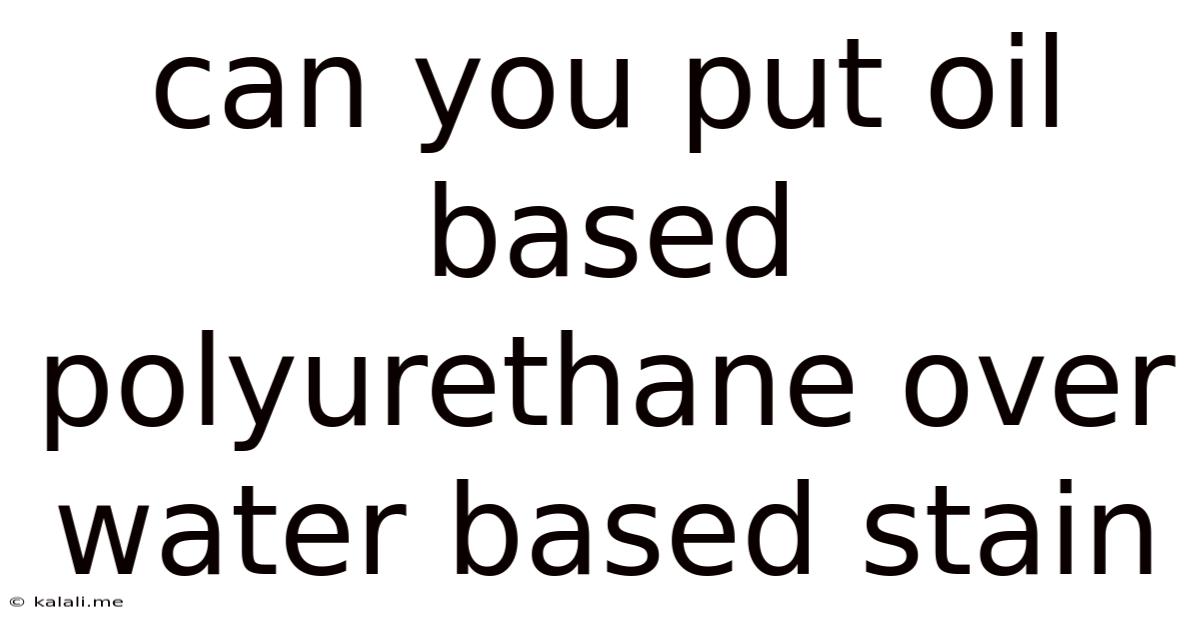Can You Put Oil Based Polyurethane Over Water Based Stain
Kalali
Jun 10, 2025 · 3 min read

Table of Contents
Can You Put Oil-Based Polyurethane Over Water-Based Stain? The Definitive Guide
Meta Description: Wondering if you can apply oil-based polyurethane over a water-based stain? This comprehensive guide explores the compatibility, potential problems, and best practices for achieving a durable and beautiful finish. Learn about the crucial factors to consider before starting your project.
Applying a protective finish to your woodworking project is crucial for longevity and beauty. A common question among DIY enthusiasts revolves around the compatibility of different finish types. Specifically, many wonder: can you put oil-based polyurethane over water-based stain? The short answer is: it's generally not recommended, but with careful preparation, it might be possible. Let's delve into the details.
Understanding the Chemistry
The core issue lies in the chemical properties of water-based and oil-based products. Water-based stains utilize water as a solvent, while oil-based stains use mineral spirits or other solvents. Similarly, oil-based polyurethane is dissolved in mineral spirits, whereas water-based polyurethane uses water. Applying oil-based polyurethane over a water-based stain introduces a potential incompatibility. The oil-based polyurethane may not adhere properly to the water-based stain, leading to several problems.
Potential Problems
-
Poor Adhesion: The most significant risk is poor adhesion. The oil-based polyurethane might not bond effectively with the water-based stain, resulting in peeling, chipping, or bubbling of the finish. This is because the oil and water don't mix, creating a barrier preventing proper bonding.
-
Blooming: The water in the stain could react with the oil-based polyurethane, leading to a phenomenon called blooming. This manifests as a cloudy or milky appearance on the surface.
-
Longer Drying Time: The combination of oil and water-based products might extend the drying time significantly, increasing the risk of dust or debris sticking to the wet finish.
-
Uneven Finish: Inconsistencies in the application process, particularly if the water-based stain hasn't fully cured, could lead to an uneven final finish.
When It Might Work (With Extreme Caution)
While generally discouraged, there are very specific situations where applying oil-based polyurethane over a water-based stain might be feasible, but only with meticulous preparation and awareness of potential risks.
-
Thorough Drying: The water-based stain must be completely dry and cured. This could take several days, even weeks, depending on the stain, wood type, and environmental conditions. Check the stain manufacturer's instructions for the recommended drying time.
-
Sanding: Light sanding with very fine-grit sandpaper (220-grit or higher) after the stain has fully cured can help create a better surface for adhesion. Remove all sanding dust before applying the polyurethane.
-
Test Area: Always test the compatibility in an inconspicuous area first. Apply a small amount of polyurethane and observe it for at least 24 hours. Check for any signs of blooming, poor adhesion, or other issues.
The Safer Alternative: Sticking with the Same Base
The most reliable approach is to maintain consistency in your finish system. If you're using a water-based stain, use a water-based polyurethane. Conversely, if you opt for an oil-based stain, use an oil-based polyurethane. This ensures optimal compatibility and minimizes the risk of problems.
Conclusion
While technically possible under very specific and carefully controlled conditions, applying oil-based polyurethane over water-based stain carries considerable risk. The potential for poor adhesion, blooming, and other issues significantly outweighs the benefits. To ensure a durable and beautiful finish for your woodworking project, it's strongly recommended to use a finish system with a consistent base – either all water-based or all oil-based. Choosing the same base will guarantee the best results and save you time and frustration in the long run.
Latest Posts
Latest Posts
-
How Old Is Someone Born In 1962
Jul 01, 2025
-
How Many Yards Are In 60 Feet
Jul 01, 2025
-
How Many Ears Of Corn To A Bushel
Jul 01, 2025
-
How Many Months Are In A Quarter
Jul 01, 2025
-
How Much Does A 12 Pack Of Pop Weigh
Jul 01, 2025
Related Post
Thank you for visiting our website which covers about Can You Put Oil Based Polyurethane Over Water Based Stain . We hope the information provided has been useful to you. Feel free to contact us if you have any questions or need further assistance. See you next time and don't miss to bookmark.